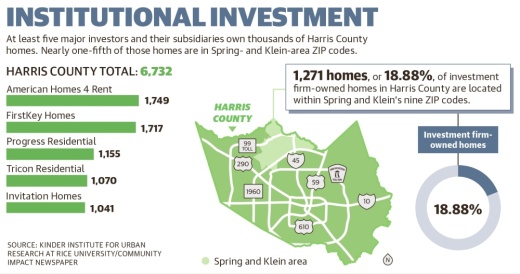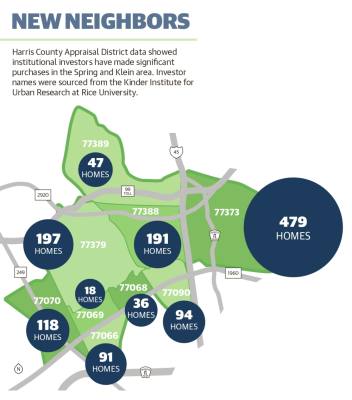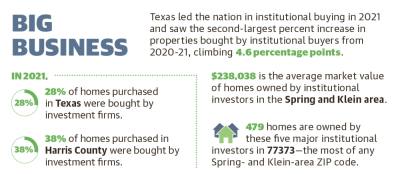However, after supply chain shortages began at the onset of the pandemic, Tillis said construction came to a halt and prices skyrocketed, forcing the family of four to scrap their original plan and move into a two-bedroom apartment. The family then shifted its focus from buying to renting.
Like Tillis, a housing shortage is driving many people into renting in the Greater Houston area, according to the Houston Association of Realtors. Large investment firms are converting single-family homes to rentals and building communities to rent in Spring and Klein to help the meet rising rental demand. However, for Tillis and many others, the supply is still not enough.
“It has been so disheartening,” she said. “The prices are so high, and the criteria is ridiculous. Things like this is what forces people who are paycheck to paycheck to become homeless.”
The HAR reported June 15 that year-over-year rentals increased 24.8% from May 2021 to May 2022. While rising mortgages and low inventory are contributing to the trend, experts said potential homebuyers are also facing competition from real estate investment firms, or institutional buyers, buying properties to sell or lease out as rentals of their own.
“Buyers today are having to make hard decisions to not buy and stay in rentals due to median home pricing increasing, higher interest rates, higher taxes and [inflation]—all of which is making a need for more rental options to be on the ground,” said Paula Wehring, a Realtor with the Paula Wehring Group.
Institutional investors
Nadia Evangelou, the director of forecasting at the National Association of Realtors, described the firms targeting properties as “Wall Street-level” buyers looking for an investment.
“These are not mom and pop buyers. They look to buy properties and communities on a large scale and make profit from them,” Evangelou said.
Texas leads the nation in institutional buying with 28% of single-family homes purchased by firms—more than double the national average of 13%. The state also saw the second-largest percent increase in properties bought by institutional buyers from 2020-21, climbing 4.6%.
David Howard, executive director of the National Rental Home Council, said the term “institutional investors” is a catch-all for companies large and small as well as individuals. According to Howard, out of 23 million single-family rental homes in the U.S., 300,000 are owned by large companies, or around 1.3%.
Locally, NAR data showed 38% of single-family properties purchased in Harris County in 2021 were bought by institutional buyers. Property data from the Harris County Appraisal District shows nearly 1,300 homes in the nine ZIP codes that make up the Spring and Klein area are owned by five institutional buyers and their subsidiaries: American Homes 4 Rent, Progress Residential, FirstKey Homes, Invitation Homes and Tricon Residential.
In ZIP code 77373, 479 homes are owned by these five major institutional investors—the most of any area ZIP code. Meanwhile, data shows FirstKey Homes has the strongest foothold with 339 homes owned across the area’s nine ZIP codes.
Additionally, while a majority of households in the Spring area were owner occupied in 2020, ZIP codes 77070 and 77090 had a majority of renter-occupied housing units, according to American Community Survey five-year estimates.
Evangelou said the trend causes first-time, low-income buyers to face steeper competition for home purchases as firms tend to target the same properties they would buy.
“If you’re [selling] at an entry-level price point, you’re going to get 20-30 offers, and cash is king because they don’t require an appraisal; they’re waiving inspections; and it’s an easier close. So that’s when investors can just steamroll over a newly married couple,” said Jenny Hill, a real estate agent with Coldwell Banker Realty.
Build to rent
Firms have also been developing entire build-to-rent communities. Howard said two years ago, 3% of NRHC companies were building homes for rent, compared to 26% in 2022.
“People are familiar with the fact that there’s a supply crisis when it comes to purchasing a home. But I think people are less familiar with the fact that there’s just as severe a supply crisis in the rental housing market,” Howard said.
HAR data showed new single-family rental listings increased 28.6% from May 2021 to May 2022.
A 2022 study conducted by researchers at the University of California at Berkeley found American Homes 4 Rent and the Canada-based Tricon Residential had invested millions of dollars as of the fourth quarter of 2021 in developing homes for rent.
Locally, CDC Houston began site preparation for Phase 1 of City Place’s new 400-acre residential project with DMB Development in May, which officials said will include single-family rental options. “Given the high demand for rental in the Houston region, we decided to integrate single-family rental into the first phase of our residential project,” CDC Houston Project Manager Andrew Giammalva said. “We want to give [transient] employees an opportunity to live in a home without having to purchase a home.”
Just north of Spring in Tomball, Tricon Residential and HHS Residential broke ground in December on Willow Creek Manors—a new single-family rental home community slated to open 14 units on FM 2920 later this year.
Invitation Homes and American Homes 4 Rent did not respond to a request for comment, and FirstKey Homes referred Community Impact Newspaper to the NRHC for comment.
Long-term impacts
Institutional buying trends emerged as the housing industry is facing record lows in inventory. In May, the HAR reported the Houston-area market had 1.6 months of supply—the highest mark since October 2021 yet below the six-month mark the NAR considers a “balanced” market.
Jennifer Wauhob, chair of the board for the HAR, said in a June 15 news release that conditions “appeared to be calming.”
“New listings increased 9% in May, helping boost inventory to its highest level of the year, so hopefully we can begin to see signs of normalcy in terms of supply, demand and pricing in the months ahead,” Wauhob said.
Charlie Kriegel, who partners with firms for the Houston-based Winhill Advisors-Kirby, said although investment firms were pivoting toward build-to-rent communities, institutional home purchases would “never go away.” NAR data showed from 2015-20, national market shares dropped from 15.4% to 11.8% before rising to 13.1% in 2021.
“Build-to-rent is the fastest-growing segment of real estate in America—it’s not going anywhere,” he said.
Kriegel said national trends could see at least 40% of single-family homes owned by firms, which would change the homebuying dynamic.
“There’s no negotiating with an institutional buyer,” he said. “Anyone who’s buying for under $400,000 will need to understand that.”










